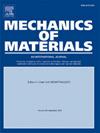用深度学习-符号回归方法定量预测和评价非晶带的硬度
IF 4.1
3区 材料科学
Q2 MATERIALS SCIENCE, MULTIDISCIPLINARY
引用次数: 0
摘要
非晶带因其有利的机械、物理和电磁特性而适用于各个领域。其中,维氏硬度(Hv)是一种基础特性,与其他特性密切相关,因此吸引了越来越多研究人员的关注。在本研究中,作者在之前收集的数据集上执行了九种机器学习(ML)算法。通过比较这些算法在测试集上的决定系数(R2),得出了准确度最高的模型的描述符排序。然后,通过综合不同特征子集的 R2 值、描述符排名和皮尔逊相关系数(PCC),利用三个关键描述符成功探索出了最终表达式。此外,在探索过程中还阐明了这些特征与 Hv 之间错综复杂的关系。这一框架的功效还可为发现新型非晶带的其他特性提供启示。本文章由计算机程序翻译,如有差异,请以英文原文为准。

Quantitatively predicting and evaluating the hardness of amorphous ribbons via a deep learning-symbolic regression approach
Amorphous ribbons are applicable across various fields due to their advantageous mechanical, physical, and electromagnetic properties. One such property, Vickers hardness (Hv), is foundational and intimately linked with other properties, which have attracted a growing amount of attention from researchers. However, there is a paucity of a well-performed expression for amorphous ribbons that could quantitatively guide the design of new ones with the desired Hv. In the present study, nine machine learning (ML) algorithms were executed on a dataset previously collected by the authors. By comparing the coefficients of determination (R2) of these algorithms on the test sets, the descriptor ranking of the model with the highest accuracy was obtained. Then, the final expression was successfully explored by utilizing three key descriptors, which was accomplished by synthesizing the R2 values, descriptor ranking, and Pearson Correlation Coefficient (PCC) for different feature subsets. Furthermore, the intricate relationship between these features and Hv was elucidated during exploration. The efficacy of this framework may also offer insights into the discovery of other properties of novel amorphous ribbons.
求助全文
通过发布文献求助,成功后即可免费获取论文全文。
去求助
来源期刊

Mechanics of Materials
工程技术-材料科学:综合
CiteScore
7.60
自引率
5.10%
发文量
243
审稿时长
46 days
期刊介绍:
Mechanics of Materials is a forum for original scientific research on the flow, fracture, and general constitutive behavior of geophysical, geotechnical and technological materials, with balanced coverage of advanced technological and natural materials, with balanced coverage of theoretical, experimental, and field investigations. Of special concern are macroscopic predictions based on microscopic models, identification of microscopic structures from limited overall macroscopic data, experimental and field results that lead to fundamental understanding of the behavior of materials, and coordinated experimental and analytical investigations that culminate in theories with predictive quality.
 求助内容:
求助内容: 应助结果提醒方式:
应助结果提醒方式:


